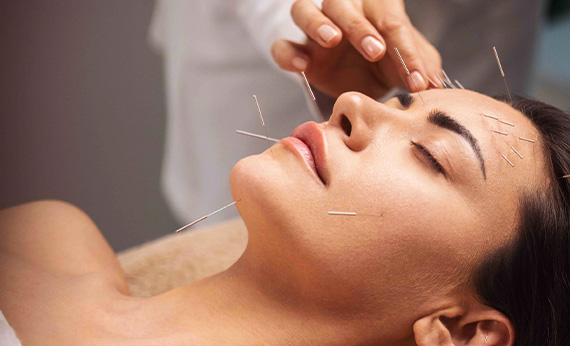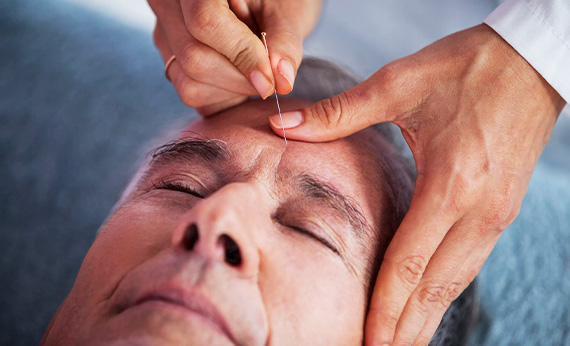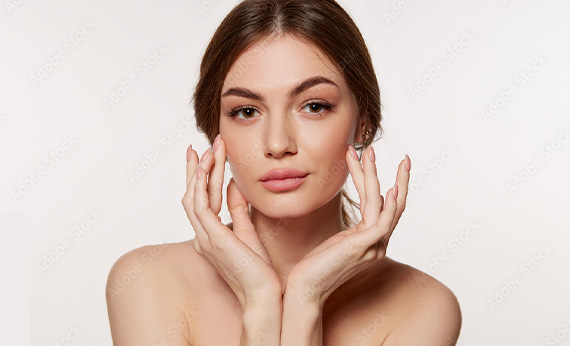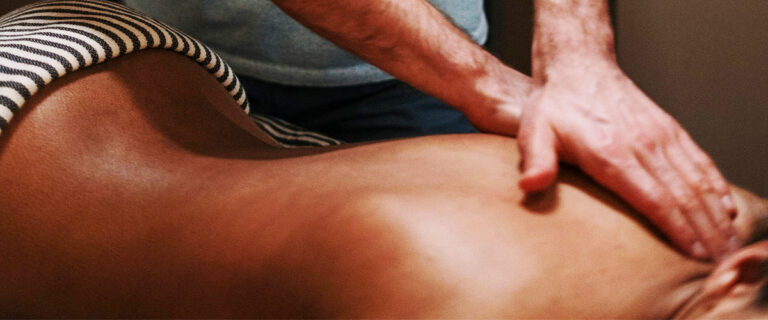Facial acupuncture is a natural treatment that enhances skin health and appearance using fine needles. As a popular alternative to invasive procedures, it stimulates the skin’s healing processes. In this article, we explain what facial acupuncture is, how it works, its key benefits, and what you can expect during a session.
Key Takeaways
- Facial acupuncture rejuvenates the skin by stimulating collagen and elastin production through the insertion of fine needles, promoting overall skin health.
- This holistic treatment addresses common skin concerns, including fine lines, acne, and hyperpigmentation, while enhancing blood circulation and lymphatic drainage.
- Facial acupuncture offers a natural alternative to more invasive cosmetic procedures like Botox, providing long-term and gradual improvements in skin appearance with minimal side effects.
Understanding Facial Acupuncture

Facial acupuncture treatment, also known as cosmetic acupuncture, facial rejuvenation, or facial rejuvenation acupuncture, is a holistic treatment that uses the principles of Traditional Chinese Medicine (TCM) to rejuvenate the skin. It involves the insertion of fine needles into specific acupuncture points on the face, neck, and ears to stimulate the skin’s natural healing processes. According to TCM, imbalances in the flow of vital energy, or qi, can accelerate skin aging, and facial acupuncture aims to restore this balance to promote healthier, more youthful skin.
As part of the growing ‘notox’ movement, which favours natural skincare solutions over synthetic ones, facial acupuncture has gained popularity among those seeking a gentler approach to facial rejuvenation. This method not only targets the surface of the skin but also addresses underlying imbalances, offering a comprehensive approach to beauty and wellness.
With a rise in the preference for natural skincare, facial acupuncture has become a go-to for those looking to achieve facial rejuvenation without invasive procedures.
How Does Facial Acupuncture Work?
Facial acupuncture works by creating microtraumas in the skin through the insertion of fine acupuncture needles. These microtraumas stimulate the body’s natural healing response, leading to increased production of collagen and elastin, which are essential for maintaining skin firmness and elasticity. Enhanced local microcirculation from facial acupuncture ensures efficient delivery of oxygen and nutrients to skin cells, promoting healthier skin and a more radiant complexion.
One of the key benefits of facial acupuncture is its ability to relax tightened facial muscles, which helps minimize fine lines and wrinkles. Targeting specific acupuncture points, this treatment effectively reduces the appearance of aging signs while also improving blood flow and lymphatic drainage. This holistic approach not only addresses visible skin concerns but also enhances overall skin health by promoting tissue repair and reducing inflammation.
To achieve optimal results, patients typically undergo 10 to 14 sessions, scheduled twice a week for 5 to 7 weeks. This consistent treatment schedule allows for cumulative improvements in skin appearance and texture. With each session, the skin becomes firmer, more elastic, and better able to retain moisture, resulting in a youthful and revitalized complexion.
What Happens During a Facial Acupuncture Session?
A typical facial acupuncture session at gesund in downtown Toronto begins with an initial health assessment conducted by our Registered Acupuncturist or Naturopathic doctor. This helps to identify any underlying health issues and tailor the treatment to the patient’s specific needs. The areas treated during a session include the face, neck, and ears, where fine acupuncture needles are inserted into specific points. These needles are significantly thinner than those used in standard body acupuncture, ensuring minimal discomfort.
Patients often find facial acupuncture to be a relaxing experience. The insertion of needles causes microtrauma that triggers an inflammatory response, stimulating collagen production and enhancing blood flow. While some may experience slight sensitivity, the overall sensation is generally soothing. Additionally, complementary treatments such as LED therapy, facial cupping, or masking may be incorporated to enhance the effects of the acupuncture session.
A complete course of facial acupuncture typically consists of around 10-12 sessions, leading to lasting improvements in skin appearance. Patients often notice a significant reduction in fine lines, improved skin firmness, and a more youthful complexion by the end of the cosmetic acupuncture session treatment course. The holistic nature of facial acupuncture not only addresses cosmetic concerns but also promotes overall well-being.
Key Benefits of Facial Acupuncture

Regular sessions of facial acupuncture can lead to firmer skin by stimulating the production of collagen and elastin, which are crucial for maintaining skin elasticity and firmness. This natural stimulation helps diminish fine lines and wrinkles, providing a more youthful and radiant complexion. Enhanced blood circulation and improved skin texture are notable outcomes of this treatment, contributing to healthier and more resilient skin.
Facial acupuncture effectively addresses a variety of skin issues, including dullness, dryness, and mild acne. This technique reduces puffiness and improves overall skin tone by promoting blood flow and lymphatic drainage. The suction effect of facial cupping, often used in conjunction with acupuncture, further enhances blood circulation and diminishes facial swelling, resulting in a more contoured and vibrant appearance.
Beyond its cosmetic benefits, facial acupuncture also contributes to overall skin health. The treatment can improve skin resilience, making it beneficial for individuals with mild acne and other skin concerns. Addressing underlying imbalances and promoting relaxation, facial acupuncture ensures long-term improvements and a youthful glow through its holistic approach to skincare.
Addressing Common Skin Concerns with Facial Acupuncture
Facial acupuncture is a versatile treatment that can address a range of common skin concerns. From reducing wrinkles and fine lines to treating acne and hyperpigmentation, this holistic approach offers comprehensive solutions for various skin issues. Additionally, facial acupuncture addresses these concerns effectively.
In the following subsections, we will delve into how facial acupuncture tackles specific concerns, providing detailed insights into its effectiveness.
Wrinkles and Fine Lines
Facial acupuncture acts as a form of collagen induction therapy, which is highly effective in reducing the appearance of fine lines and wrinkles. By encouraging collagen and elastin production, this treatment helps to restore the skin’s natural elasticity and firmness. As we age, the reduction in collagen and elastin contributes to the formation of wrinkles, but facial acupuncture can counteract these effects by promoting the skin’s natural healing processes.
Targeted facial stimulation in facial acupuncture enhances collagen production, improving the appearance of both fine lines and deeper wrinkles. This approach not only reduces visible signs of aging but also helps prevent further skin deterioration. The result is a smoother, more youthful complexion with improved skin texture and elasticity.
Acne and Blemishes
Facial acupuncture is particularly beneficial for individuals suffering from acne and blemishes. Regulating hormonal imbalances and improving blood circulation, this treatment reduces the occurrence of acne breakouts. The enhanced lymphatic drainage resulting from facial acupuncture also aids in reducing facial swelling and promoting clearer skin.
The combined effects of improved circulation and lymphatic drainage work together to reduce acne and blemishes, leading to a more radiant complexion. Patients who struggle with persistent acne may find significant relief through regular facial acupuncture sessions, which not only address the symptoms but also target the underlying causes of acne.
Hyperpigmentation and Age Spots
Hyperpigmentation and age spots can be effectively addressed through facial acupuncture. Enhancing blood flow and lymphatic drainage, this treatment lightens brown spots and reduces discoloration. Conditions like melasma and age spots can see significant improvement with regular facial acupuncture sessions.
This method promotes cellular renewal, which is essential for diminishing age spots and evening out skin tone. While multiple sessions may be necessary for significant results, the overall improvement in skin appearance and health makes facial acupuncture a valuable option for those dealing with hyperpigmentation and age spots.
Comparing Facial Acupuncture to Botox and Dermal Fillers

Facial acupuncture offers a more gradual and long-lasting improvement in skin appearance compared to Botox or dermal fillers, which provide immediate but temporary results. While Botox targets wrinkles by temporarily paralyzing facial muscles, facial acupuncture works by stimulating the body’s natural healing processes. This approach not only preserves natural facial expressions but also addresses the underlying causes of skin aging, such as sun damage and collagen depletion.
The risks associated with facial acupuncture are generally less severe than those linked to Botox and dermal fillers. Facial acupuncture does not interfere with facial muscle function, reducing the likelihood of a frozen appearance. As the trend towards natural rejuvenation methods grows, facial acupuncture is increasingly seen as a viable alternative to invasive cosmetic procedures.
Potential Side Effects and Safety Considerations
While facial acupuncture is generally safe, there are potential side effects to be aware of. Common adverse effects include temporary soreness, bruising, and minor bleeding at the needle insertion sites. In some cases, symptoms may temporarily worsen before improving. However, these side effects are typically mild and short-lived.
To minimize risks, it is essential to work with a licensed and experienced practitioner who uses sterile, single-use needles. Informing the practitioner about any medical devices or conditions, such as pacemakers or pregnancy, is crucial to ensure safety. Adhering to these precautions allows patients to enjoy the health benefits of facial acupuncture with minimal risk.
Who Should Try Facial Acupuncture?

Facial acupuncture is ideal for individuals seeking non-invasive beauty treatments that offer both cosmetic and health benefits. Those with specific skin concerns, such as acne, signs of aging, or hormonal imbalances, may find this treatment particularly beneficial. Additionally, individuals looking to avoid the potential side effects of invasive procedures like Botox may prefer the natural approach of facial acupuncture.
This treatment is also suitable for those interested in a holistic approach to beauty and wellness. Addressing underlying health issues and promoting overall well-being, facial acupuncture enhances not only skin appearance but also mental and physical health. Whether you are looking to improve your skin or achieve a better balance in your life, facial acupuncture offers a comprehensive solution.
Maintenance and Long-term Results
To achieve the desired results from facial acupuncture, a typical treatment course involves 10-14 sessions, usually scheduled twice a week for 5-7 weeks. Following the initial treatment course, maintenance sessions are recommended monthly for the first 2-3 months and then seasonally to sustain the results. This regular maintenance helps counteract the effects of aging and environmental factors like gravity and sun exposure.
The visible improvements from facial acupuncture can last between 3 to 5 years, depending on the individual’s maintenance routine. Regular treatments not only maintain and enhance skin firmness but also reinforce muscle tone, ensuring long-term benefits. Committing to a consistent maintenance schedule allows patients to enjoy lasting improvements in their skin’s appearance and overall health.
Alternatives to Facial Acupuncture
For those seeking alternatives to facial acupuncture, several other holistic treatments are available. These alternatives include:
- Gua Sha
- Facial cupping
- Holistic practices like Reiki
- Ayurveda
Each of these methods offers unique benefits and can be used to complement or replace facial acupuncture depending on individual preferences and needs.
Gua Sha
Gua Sha is a needle-free technique that enhances skin vitality and promotes lymphatic drainage. Using a smooth-edged tool to scrape the skin, Gua Sha improves blood flow and promotes healthier skin without the use of needles. This method is particularly effective in reducing puffiness and enhancing skin texture, offering a natural alternative to facial acupuncture.
Facilitating lymphatic flow, Gua Sha detoxifies the skin and reduces inflammation. This technique can be incorporated into a regular skincare routine to maintain a radiant complexion and improve overall skin health. For those who prefer a needle-free approach, Gua Sha provides a gentle yet effective method for facial rejuvenation.
Facial Cupping
Facial cupping is another effective alternative to facial acupuncture, involving the placement of small suction cups on the skin. This technique promotes blood circulation and encourages lymphatic drainage, which can significantly reduce facial swelling and puffiness. Improved blood flow not only enhances skin health but also contributes to a more radiant complexion.
The suction effect of facial cupping helps to lift and tone the facial muscles, providing a natural facelift effect. This method can be particularly beneficial for those looking to improve skin elasticity and reduce the appearance of fine lines and wrinkles.
Incorporating facial cupping into your skincare routine provides similar benefits to facial acupuncture without using needles.
Reiki and Ayurveda
Reiki and Ayurveda offer holistic approaches to skincare that focus on energy healing and balance. Reiki, a Japanese practice, involves the transfer of energy through the hands to promote healing and relaxation. This method can improve overall skin health by reducing stress and promoting a sense of well-being.
Similarly, Ayurveda, an ancient Indian system of medicine, emphasizes balance in body, mind, and spirit for achieving optimal skin health. Ayurvedic practices, such as the use of rejuvenating herbs like ashwagandha and turmeric, can enhance skin vitality and address underlying imbalances.
These natural approaches to skincare offer a comprehensive solution for those looking to improve their skin without invasive procedures. Incorporating Reiki and Ayurveda into your skincare routine achieves a harmonious balance that promotes both inner and outer beauty.
Facial Acupuncture for Overall Health

Facial acupuncture is not just about enhancing skin appearance; it also offers significant overall health benefits. This holistic treatment can help balance hormones, alleviate conditions related to menopause, PMS, and thyroid function, and improve sleep quality. Addressing both cosmetic and health concerns, facial acupuncture promotes a sense of well-being and enhances mental health.
Furthermore, facial acupuncture can relieve physical issues such as headaches, sinus congestion, and symptoms related to TMJ disorders. It also reduces stress and anxiety, contributing to improved mental well-being and self-esteem. By promoting relaxation and addressing underlying health issues, facial acupuncture offers a comprehensive approach to beauty and wellness that goes beyond skin-deep benefits.
Summary
Facial acupuncture stands out as a holistic approach to skincare that not only rejuvenates the skin but also enhances overall health and well-being. By stimulating collagen production, improving blood circulation, and promoting lymphatic drainage, this treatment effectively addresses common skin concerns such as wrinkles, acne, and hyperpigmentation. Compared to invasive procedures like Botox and dermal fillers, facial acupuncture offers a natural, gradual, and long-lasting solution with fewer risks.
Whether you are looking to reduce the signs of aging, clear up acne, or achieve a more balanced and radiant complexion, facial acupuncture provides a comprehensive and holistic approach to skincare. By incorporating regular treatments and exploring alternative therapies like Gua Sha, facial cupping, Reiki, and Ayurveda, you can maintain and enhance your skin’s health and appearance. Embrace the journey towards natural beauty and overall wellness with facial acupuncture.
Frequently Asked Questions
How many sessions of facial acupuncture do I need to see results?
To see noticeable results from facial acupuncture, you typically need 10 to 14 sessions scheduled twice a week over 5 to 7 weeks. This ensures longer-lasting improvements for up to 5 years.
What skin concerns can facial acupuncture address?
Facial acupuncture can effectively address a variety of skin concerns, including wrinkles, fine lines, acne, blemishes, hyperpigmentation, and age spots. By promoting collagen production and enhancing circulation, it helps achieve healthier skin.
Are there any side effects of facial acupuncture?
Facial acupuncture can lead to temporary soreness, bruising, and minor bleeding at injection sites. To minimize these risks, it is important to work with a licensed acupuncturist or naturopathic doctor.
How does facial acupuncture compare to Botox and dermal fillers?
Facial acupuncture provides a gradual and natural enhancement of skin appearance, allowing for the preservation of facial expressions, unlike Botox and dermal fillers, which can have associated risks. It’s an effective alternative for those seeking subtle improvements without compromising their natural look.
Who is an ideal candidate for facial acupuncture?
An ideal candidate for facial acupuncture is anyone seeking non-invasive beauty treatments, particularly those with specific skin concerns such as acne or signs of aging, as well as individuals aiming to enhance their overall health and well-being.



